Thermal, Spectroscopy and Luminescent Characterization of Hybrid PMMA/Lanthanide Complex Materials
Abstract
1. Introduction
2. Materials and Methods
3. Results and Discussion
3.1. Structural Characterization of Dopants
3.2. Thermal Analysis of Lanthanide Complexes
3.3. Thermal Analysis of Hybrid Composites
3.4. Luminescent Properties of Developed Complexes and Hybrid Materials
3.4.1. Eu2,6DClB/PMMA
3.4.2. Tb:2,6-DClB/PMMA
4. Conclusions
Supplementary Materials
Author Contributions
Funding
Institutional Review Board Statement
Informed Consent Statement
Data Availability Statement
Conflicts of Interest
References
- Kasap, S.; Capper, P. Springer Handbook of Electronic and Photonic Materials, 2nd ed.; Springer: Cham, Switzerland, 2017; pp. 997–1011. [Google Scholar]
- Kim, S.W.; Jyoko, K.; Toshiyuki, M.; Imanaka, N. Synthesis of Green-Emitting (La,Gd)OBr:Tb3+ Phosphors. Materials 2010, 3, 2506–2515. [Google Scholar] [CrossRef]
- Behrh, G.K.; Gautier, R.; Latouche, C.; Jobic, S.; Serier-Brault, H. Synthesis and photoluminescence properties of Ca2Ga2SiO7:Eu3+ red phosphors with intense 5D0 → 5F4 transition. Inorg. Chem. 2016, 55, 9144–9146. [Google Scholar] [CrossRef] [PubMed]
- Bünzli, J.-C.G.; Piguet, C. Taking advantage of luminescent lanthanide ions. Chem. Soc. Rev. 2005, 34, 1048–1077. [Google Scholar] [CrossRef] [PubMed]
- Martínez, E.D.; Prado, A.; González, M.; Anguiano, S.; Tosi, L.; Salazar Alarcón, L.; Pastoriza, H. Integrating photoluminescent nanomaterials with photonic nanostructures. J. Lumin. 2021, 233, 117870. [Google Scholar] [CrossRef]
- Stanley, J.M.; Holliday, B.J. Luminescent lanthanide-containing metallopolymers. Coord. Chem. Rev. 2012, 256, 1520–1530. [Google Scholar] [CrossRef]
- Laguna, M.; Gonzalez-Mancebo, D.; Ocana, M.; Parak, W.J. Rare earth based nanostructured materials: Synthesis, functionalization, properties and bioimaging and biosensing applications. Nanophotonics 2017, 6, 881–921. [Google Scholar]
- Feng, J.; Zhang, H. Hybrid materials based on lanthanide organic complexes: A review. Chem. Soc. Rev. 2013, 42, 387–410. [Google Scholar] [CrossRef]
- Bünzli, J.-C.G. On the design of highly luminescent lanthanide complexes. Coord. Chem. Rev. 2015, 293–294, 19–47. [Google Scholar] [CrossRef]
- Wang, T.; Astruc, D.; Abd-El-Aziz, A.S. Metallopolymers for advanced sustainable applications. Chem. Soc. Rev. 2019, 48, 558–636. [Google Scholar] [CrossRef] [PubMed]
- Werts, M.H.V. Making sense of lanthanide Luminescence. Sci. Prog. 2005, 88, 101–131. [Google Scholar] [CrossRef]
- Zhang, M.; Zhai, X.; Sun, M.; Ma, T.; Huang, Y.; Huang, B.; Du, Y.; Yan, C. When rare earth meets carbon nanodots: Mechanisms, applications and outlook. Chem. Soc. Rev. 2020, 49, 9220–9248. [Google Scholar] [CrossRef]
- Pang, X.; Li, L.; Wei, Y.; Yu, X.; Li, Y. Novel luminescent lanthanide(III) hybrid materials: Fluorescence sensing of fluoride ions and N,N-dimethylformamide. Dalton Trans. 2018, 47, 11530–11538. [Google Scholar] [CrossRef]
- Francisco, L.H.C.; Felinto, M.C.F.C.; Brito, H.F.; Teotonio, E.E.S.; Malta, O.L. Development of highly luminescent PMMA films doped with Eu3+β-diketonate coordinated on ancillary ligand. J. Mater. Sci. Mater Electron 2019, 30, 16922–16931. [Google Scholar] [CrossRef]
- Kai, J.; Felinto, M.C.F.C.; Nunes, L.A.O.; Malta, O.L.; Brito, H.F. Intermolecular energy transfer and photostability of luminescence-tuneable multicolour PMMA films doped with lanthanide-β-diketonate complexes. J. Mater. Chem. 2011, 21, 3796–3802. [Google Scholar] [CrossRef]
- Zhang, H.-J.; Fan, R.-Q.; Wang, X.-M.; Wang, P.; Wang, Y.-L.; Yang, Y.-L. Preparation, characterization, and properties of PMMA-doped polymer film materials: A study on the effect of terbium ions on luminescence and lifetime enhancement. Dalton Trans. 2015, 14, 2871–2879. [Google Scholar] [CrossRef]
- Yang, C.; Zhou, H.; Xu, J.; Li, Y.; Lu, M.; He, J.; Zhang, Q. A series of highly quantum efficiency PMMA luminescent films doped with Eu-complex as promising light-conversion molecular devices. J. Mater. Sci. Mater. Electron. 2016, 27, 11284–11292. [Google Scholar] [CrossRef]
- Binnemans, K. Lanthanide-Based Luminescent Hybrid Materials. Chem. Rev. 2009, 109, 4283–4374. [Google Scholar] [CrossRef] [PubMed]
- Zhang, Y.Y.; Shen, L.F.; Pun, E.Y.B.; Chen, B.J.; Lin, H. Multi-color fluorescence in rare earth acetylacetonate hydrate doped poly methyl methacrylate. Opt. Commun. 2013, 311, 111–116. [Google Scholar] [CrossRef]
- Armelao, L.; Quici, S.; Barigelletti, F.; Accorsi, G.; Bottaro, G.; Cavazzini, M.; Tondello, E. Design of luminescent lanthanide complexes: From molecules to highly efficient photo-emitting materials. Coord. Chem. Rev. 2010, 254, 487–505. [Google Scholar] [CrossRef]
- Yuanjing, C.; Yue, Y.; Qian, G.; Chen, B. Luminescent Functional Metal-Organic Frameworks. Chem. Rev. 2012, 112, 1126–1162. [Google Scholar]
- Li, W.; Yan, P.; Hou, G.; Li, H.; Li, G. Near-infrared luminescent hybrid materials—PMMA doped with a neodymium complex: Synthesis, structure and photophysical properties. RSC Adv. 2013, 3, 18173–18180. [Google Scholar] [CrossRef]
- Liu, D.; Yu, H.; Wang, Z.; Xin, L.; You, J.; Li, G. Synthesis and fluorescence properties of dysprosium-coordinated with high-Tg polyaryletherketones containing carboxyl side groups. Polym. Adv. Technol. 2011, 22, 488–494. [Google Scholar] [CrossRef]
- Zhang, H.; Fan, R.; Wang, P.; Wang, X.; Gao, S.; Dong, Y.; Wang, Y.; Yang, Y. Structure variations of a series of lanthanide complexes constructed from quinoline carboxylate ligands: Photoluminescent properties and PMMA matrix doping. RSC Adv. 2015, 5, 38254–38263. [Google Scholar] [CrossRef]
- Sivakumar, S.; Reddy, M.L.P. Bright green luminescent molecular terbium plastic materials derived from 3,5-bis(perfluorobenzyloxy)benzoate. J. Mater. Chem. 2012, 22, 10852–10859. [Google Scholar] [CrossRef]
- Yan, B.; Xi-Chen. Lanthanide coordination polymer/PMMA hybrid polymeric films: In-situ composition and photoluminescent properties. J. Optoelectron. Adv. Mater. 2007, 9, 2091–2096. [Google Scholar]
- Mergo, P.; Gil, M.; Podkościelny, W.; Worzakowska, M. Physical sorption and thermogravimetry as the methods used to analyze linear polymeric structure. Adsorption 2013, 99, 851–859. [Google Scholar] [CrossRef]
- CrysAlis PRO; Agilent Technologies Ltd.: Yarnton, UK, 2013.
- Sheldrick, G.M. Crystal structure refinement with SHELXL. Acta Crystallogr. 2015, C71, 3–8. [Google Scholar]
- Brzyska, W.; Rzączyńska, Z.; Świta, E.; Mrozek, R.; Głowiak, T. Crystal structure of dimeric octaaquabis(-2,6-dichlorobenzoato O,O,O′) tetrakis (2,6-dichlorobenzoato O) dilanthanide(III) dihydrates. J. Coord. Chem. 1997, 41, 1–12. [Google Scholar] [CrossRef]
- Silverstein, R.M.; Webster, F.X.; Kiemle, D.J. Spectrometric Identification of Organic Compounds; Wiley&Sons: New York, NY, USA, 1998. [Google Scholar]
- Holly, S.; Sohár, P. Absorption Spectra in the Infrared Region; Akadémiai Kiadó: Budapest, Hungary, 1975. [Google Scholar]
- Łyszczek, R.; Gil, M.; Głuchowska, H.; Podkościelna, B.; Lipke, A.; Mergo, P. Hybrid materials based on PEGDMA matrix and europium(III) carboxylates -thermal and luminescent investigations. Eur. Polym. J. 2018, 106, 318–328. [Google Scholar] [CrossRef]
- NIST—National Institute of Standards and Technology, US Department of Commerce. NIST Chemistry WebBook, SRD 69, Triethylamine mass spectrum (electron ionization); National Institute of Standards and Technology: Gaithersburg, MD, USA, 2018.
- Hoffmann, E.; Charette, J.; Stroobant, V. Spektrometria Mas; WNT: Warszawa, Poland, 1998. [Google Scholar]
- Johnstone, R.A.W. Spektrometria Masowa w Chemii Organicznej; PWN: Warszawa, Poland, 1975. [Google Scholar]
- Ohno, H.; Mutsuga, M.; Kawamura, Y. Identification and Quantitation of Volatile Organic Compounds in Poly(methyl methacrylate) Kitchen Utensils by Headspace Gas Chromatography/Mass Spectrometry. J. AOAC Int. 2014, 97, 1452–1458. [Google Scholar] [CrossRef]
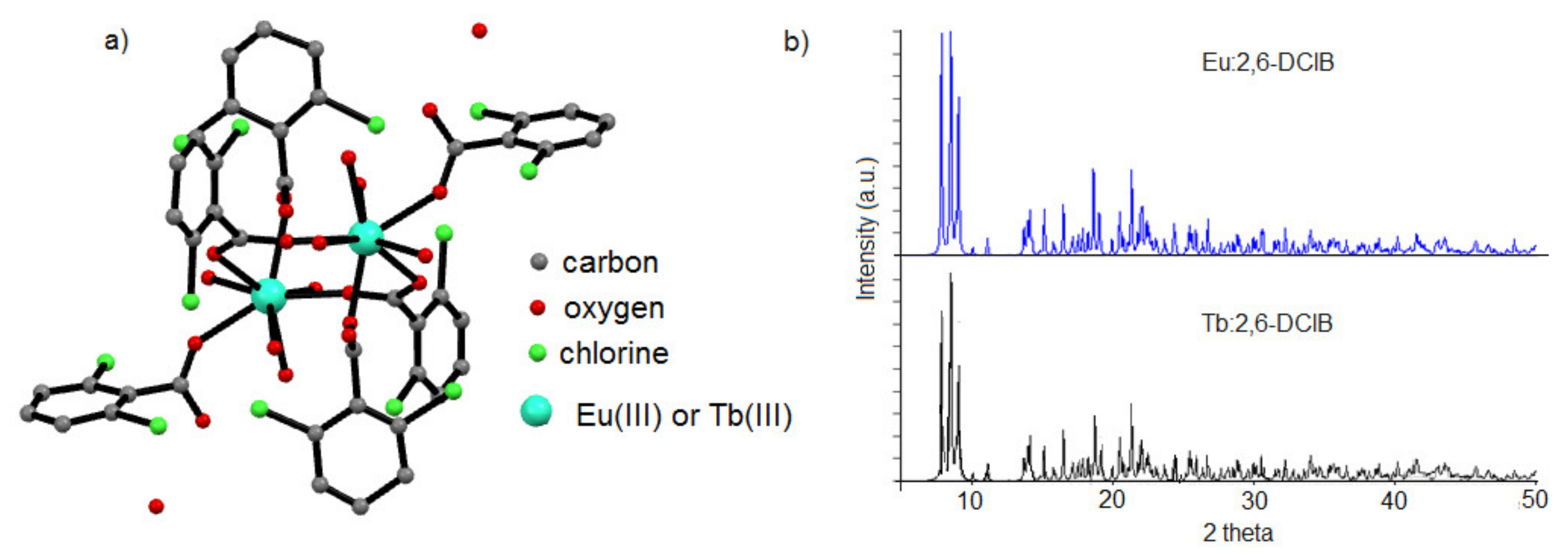
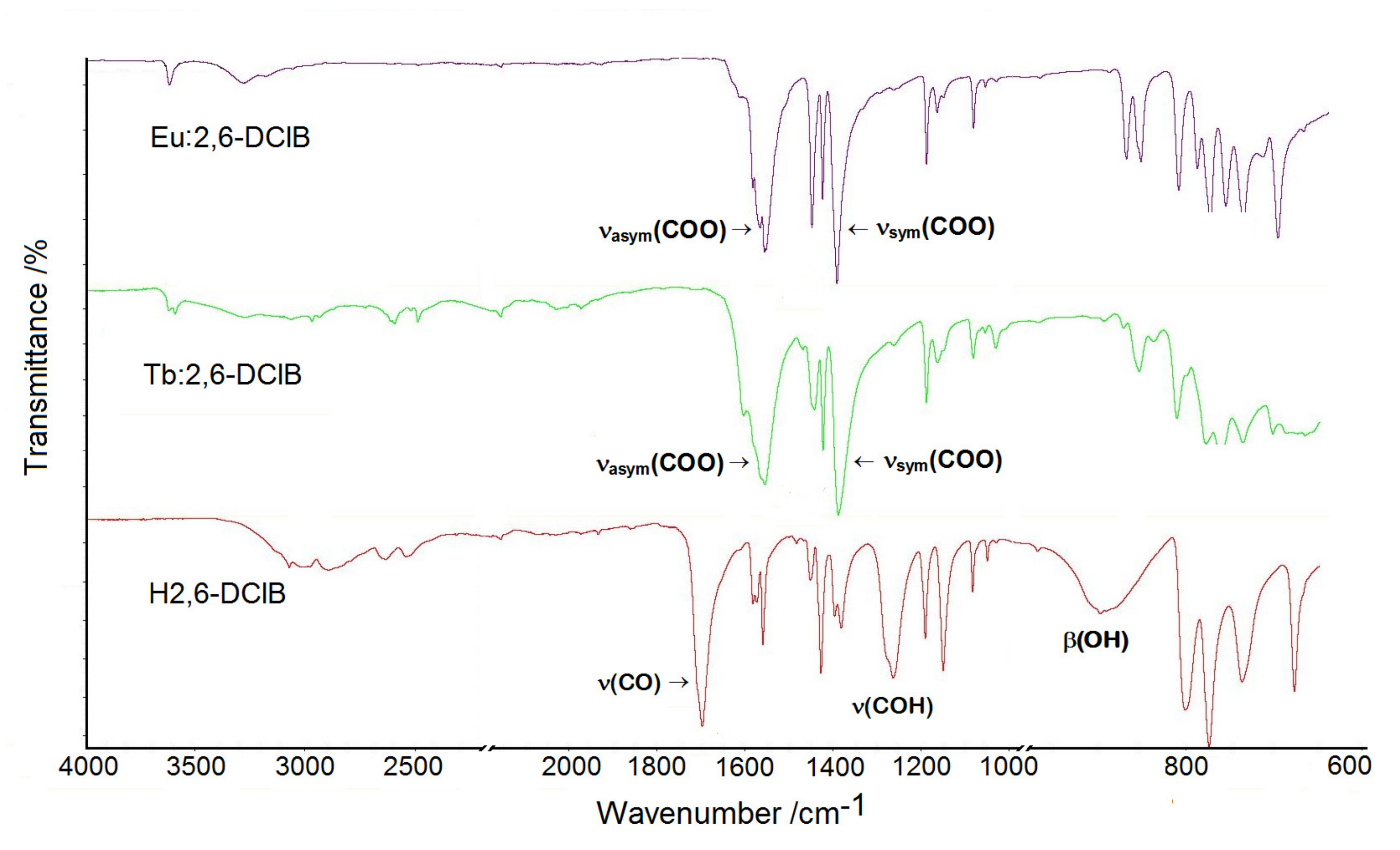
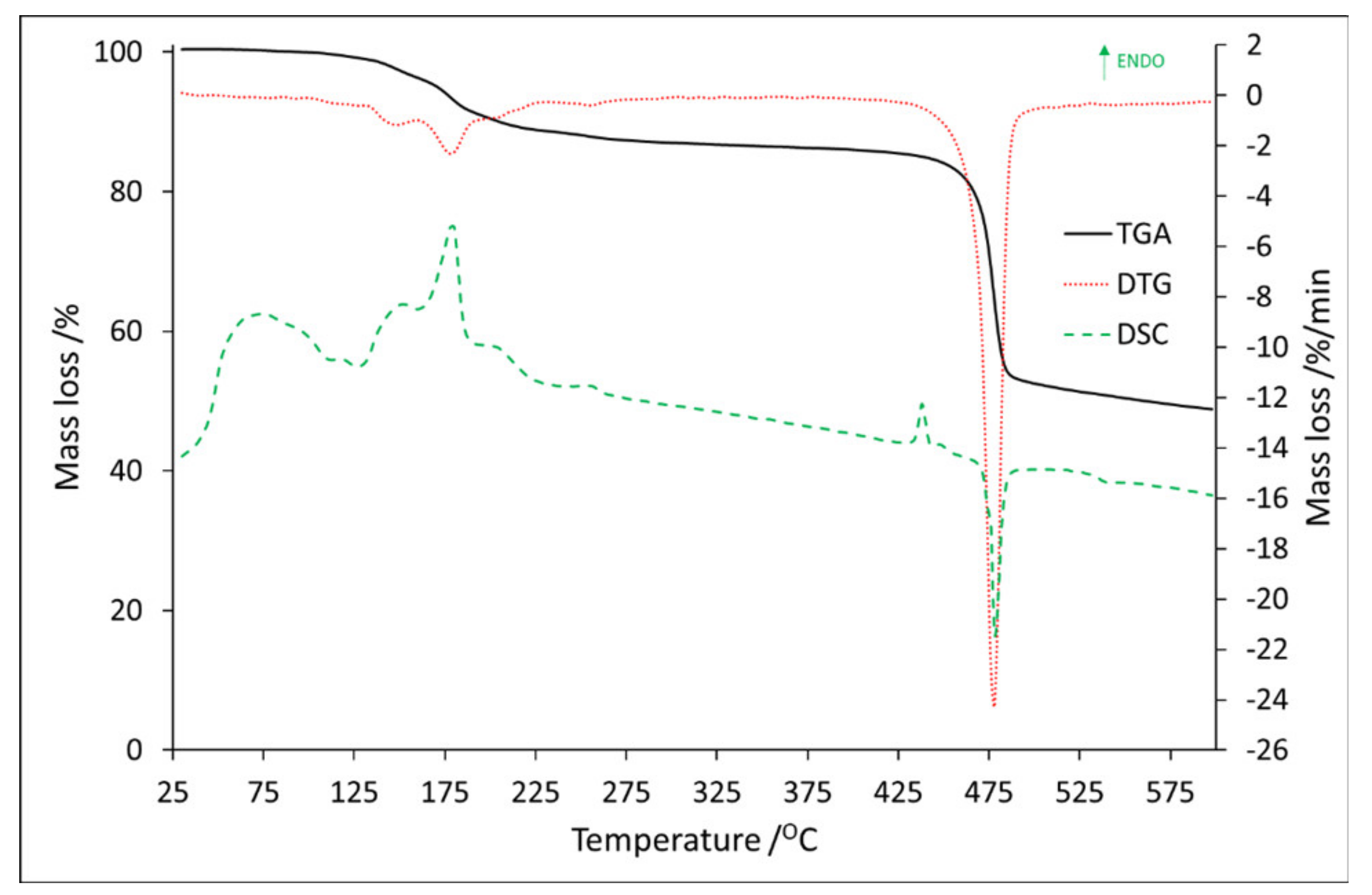
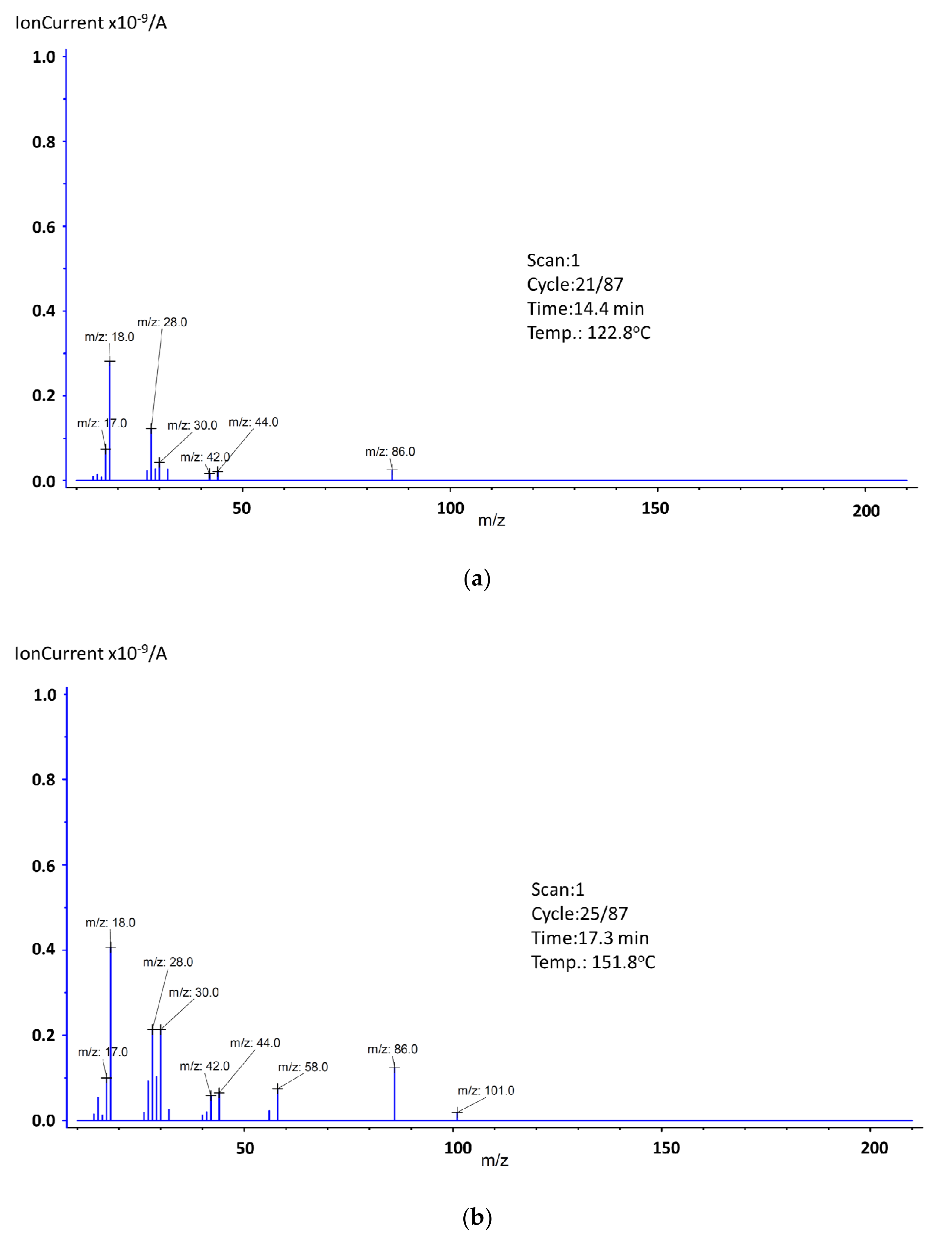


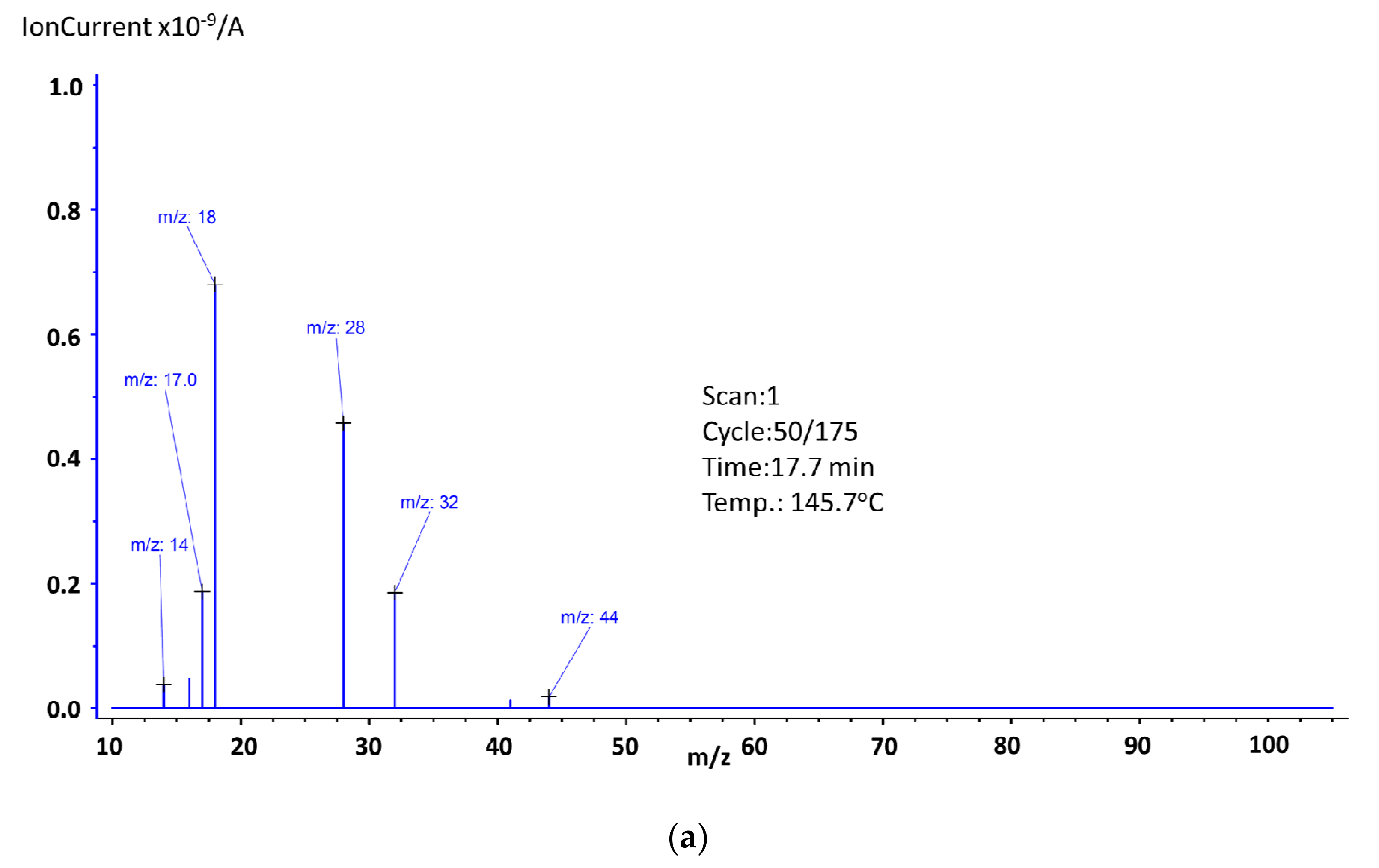
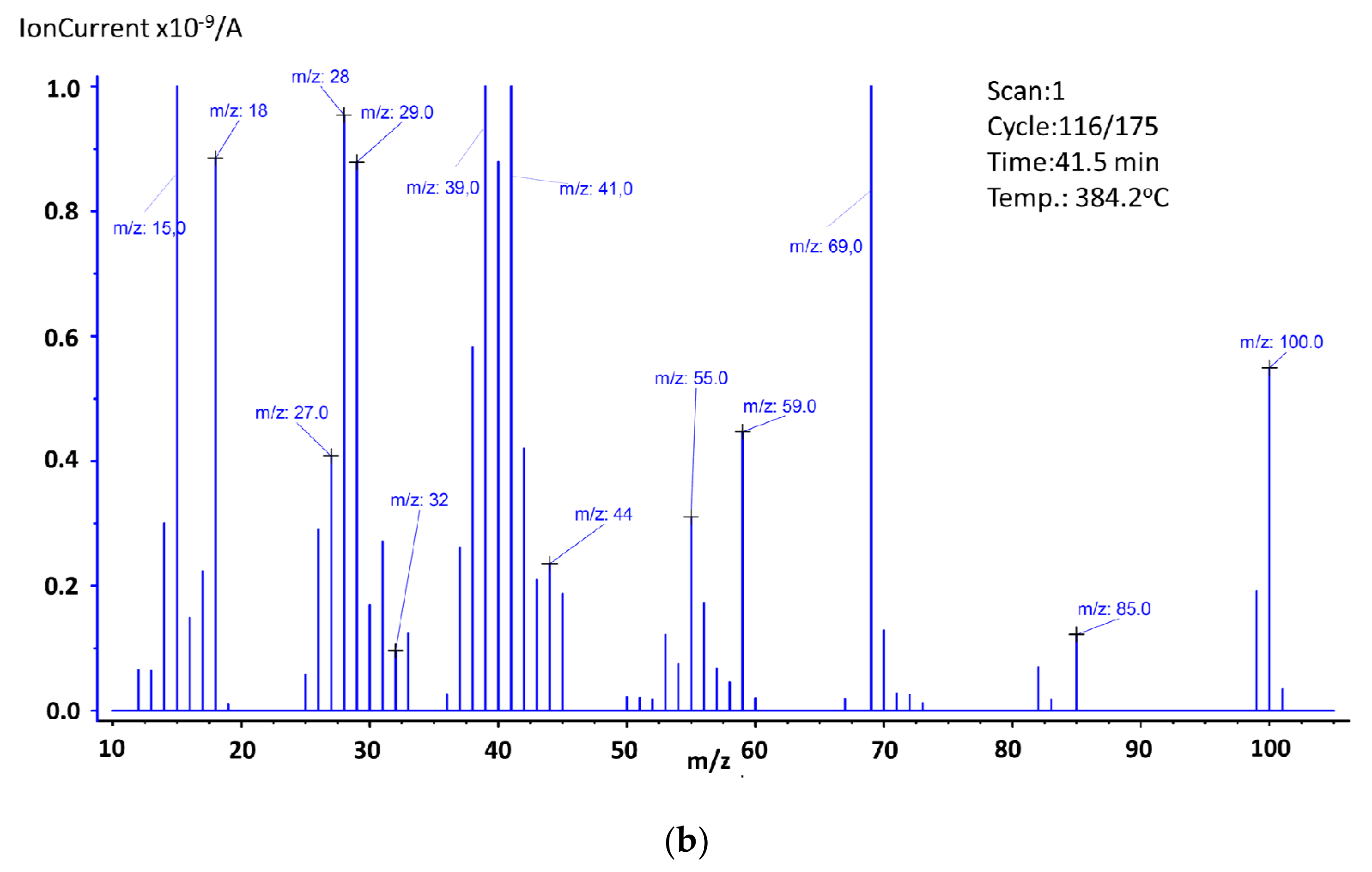



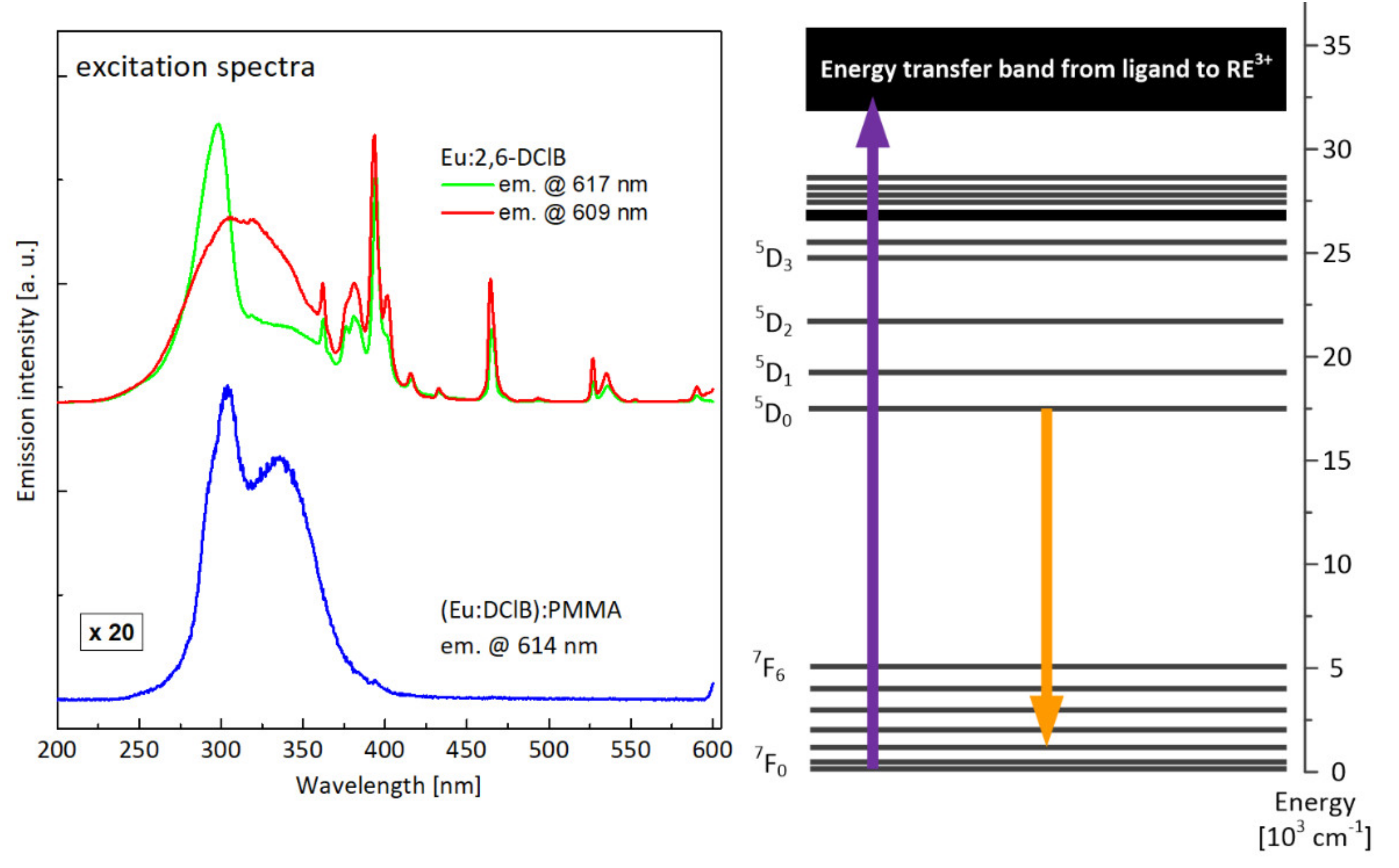
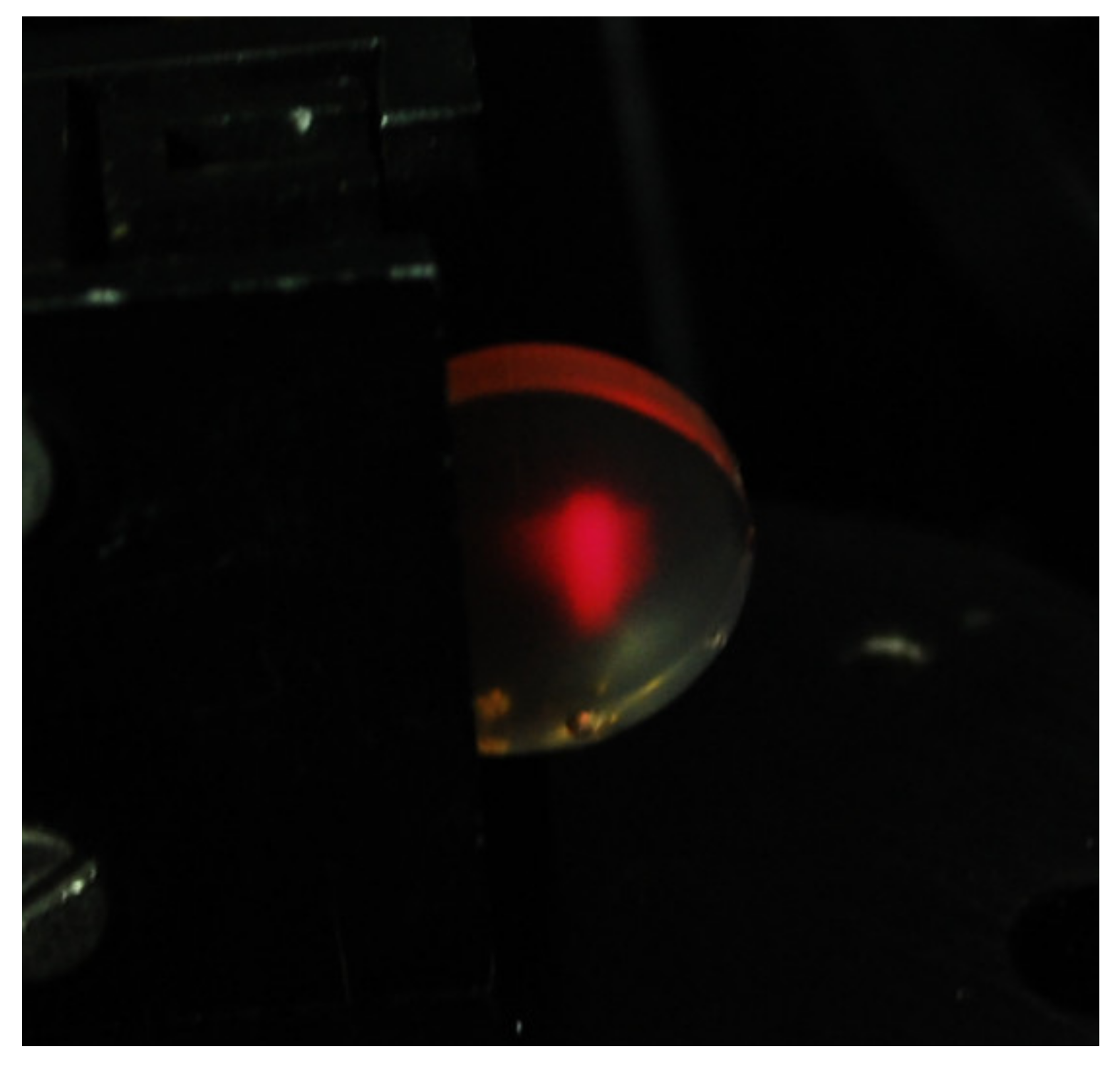


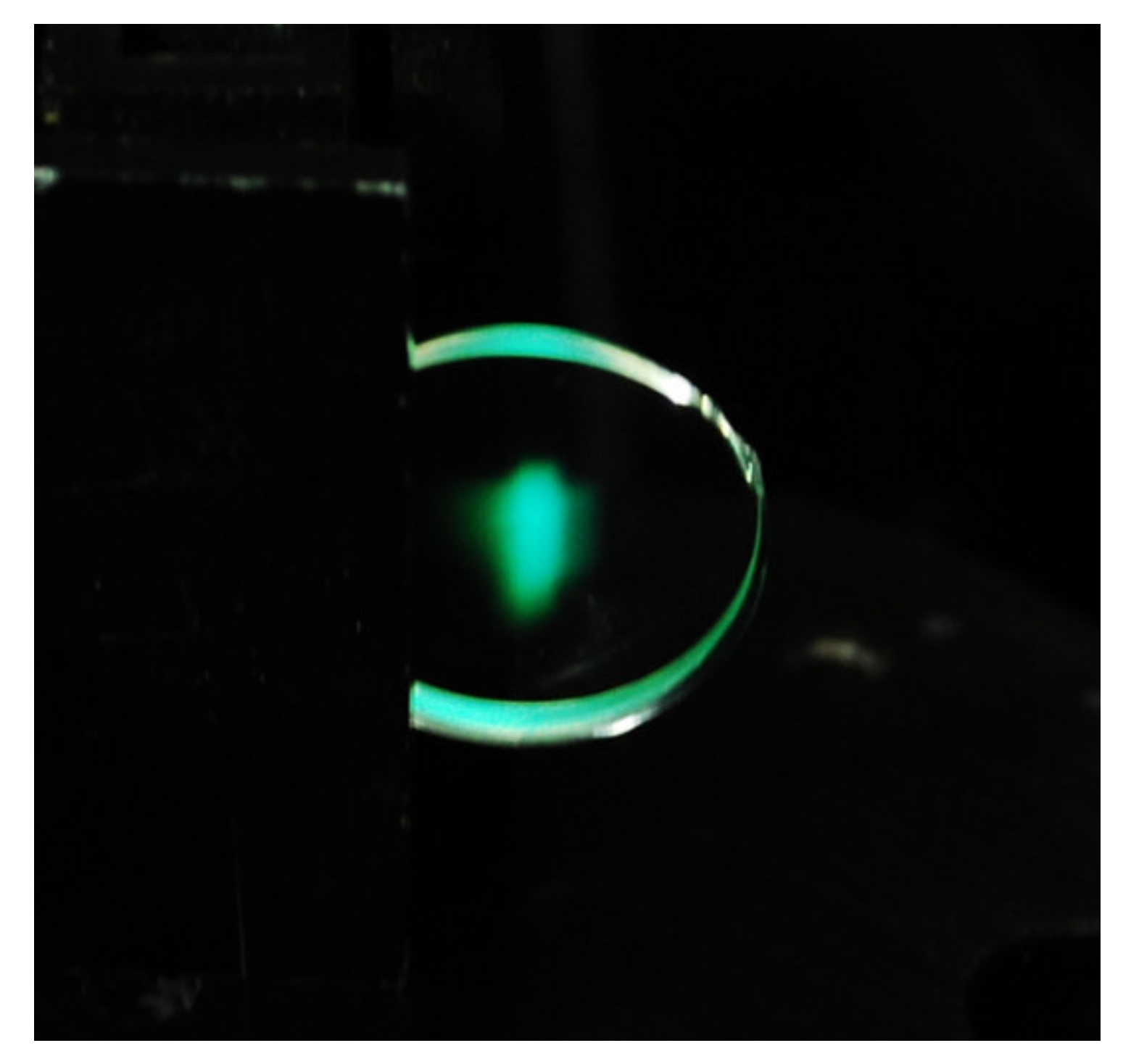
| Samples * | Dopant/wt.% | Initiator/wt.% | Chain Transfer Agent/wt.% | Methyl Methacrylate/wt.% | |
|---|---|---|---|---|---|
| Eu:2,6-DClB | Tb:2,6-DClB | - | - | - | |
| Sample No. 1 | 100 | - | 0.0 | 0.0 | 0.0 |
| Sample No. 2 | - | 100 | 0.0 | 0.0 | 0.0 |
| Sample No. 3 | 1 | - | 0.4 | 0.8 | 97.8 |
| Sample No. 4 | - | 1 | 0.4 | 0.8 | 97.8 |
| Sample No.1 | Endothermic Peak | ||||
| DTG temperature range (°C) | DSC maximum value (°C) | TG mass loss (wt.%) | |||
| 25–118 | 85 | 11.6 | |||
| Exothermic Peak | |||||
| 374–500 | 460 | 40.5 | |||
| Sample No.2 | Endothermic Peak | ||||
| DTG temperature range (°C) | DSC maximum value (°C) | TG mass loss (wt.%) | |||
| I | 100.2–132.6 | 118.6 | 1.0 | ||
| II | 132.6–159.2 | 151.7 | 2.5 | ||
| III | 159.2–201.0 | 179.4 | 6.0 | ||
| IV | 201.0–231.3 | 205.0 | 1.7 | ||
| V | 231.3–275.0 | 254.4 | 1.3 | ||
| VI | 423.7–446.5 | 437.7 | 1.1 | ||
| - | Exothermic Peak | ||||
| VII | 446.5–509 | 478.5 | 32.3 | ||
| Energy Effect | Thermal and Calorimetric Values | Sample No. 3 | Sample No. 4 | |
|---|---|---|---|---|
| Endothermic peak | I | DTG Temperature range (°C) | 123.3–190.0 | 136.0–230.0 |
| DSC maximum value (°C) | 144.8 | 172.9 | ||
| TG mass loss (wt.%) | 0.6 | 6.3 | ||
| II | DTG Temperature range (°C) | 201.3–240.1 | 240.8–310.5 | |
| DSC maximum value (°C) | 261.3 | 293.3 | ||
| TG mass loss (wt.%) | 0.8 | 10.5 | ||
| III | DTG Temperature range (°C) | 298.0–454.2 | 310.5–442.2 | |
| DSC maximum value (°C) | 383.1 | 369.0 | ||
| TG mass loss (wt.%) | 96.7 | 81.3 | ||
Publisher’s Note: MDPI stays neutral with regard to jurisdictional claims in published maps and institutional affiliations. |
© 2021 by the authors. Licensee MDPI, Basel, Switzerland. This article is an open access article distributed under the terms and conditions of the Creative Commons Attribution (CC BY) license (https://creativecommons.org/licenses/by/4.0/).
Share and Cite
Gil-Kowalczyk, M.; Łyszczek, R.; Jusza, A.; Piramidowicz, R. Thermal, Spectroscopy and Luminescent Characterization of Hybrid PMMA/Lanthanide Complex Materials. Materials 2021, 14, 3156. https://doi.org/10.3390/ma14123156
Gil-Kowalczyk M, Łyszczek R, Jusza A, Piramidowicz R. Thermal, Spectroscopy and Luminescent Characterization of Hybrid PMMA/Lanthanide Complex Materials. Materials. 2021; 14(12):3156. https://doi.org/10.3390/ma14123156
Chicago/Turabian StyleGil-Kowalczyk, Małgorzata, Renata Łyszczek, Anna Jusza, and Ryszard Piramidowicz. 2021. "Thermal, Spectroscopy and Luminescent Characterization of Hybrid PMMA/Lanthanide Complex Materials" Materials 14, no. 12: 3156. https://doi.org/10.3390/ma14123156
APA StyleGil-Kowalczyk, M., Łyszczek, R., Jusza, A., & Piramidowicz, R. (2021). Thermal, Spectroscopy and Luminescent Characterization of Hybrid PMMA/Lanthanide Complex Materials. Materials, 14(12), 3156. https://doi.org/10.3390/ma14123156








